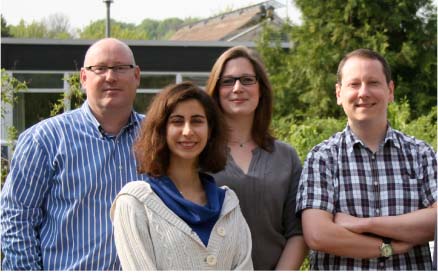The Combined Nanoscopy Technique

From left to right: Dr. Johannes Wessels, Dr. Sinem K. Saka, Katharina Kröhnert, Prof. Dr. Silvio O. Rizzoli. Prof. Rizzoli / CNMPB
Molecular processes in living cells can best be monitored by high-resolution microscopy techniques. Although groundbreaking technical innovations in the field of microscopy have been made in the past, frontiers still exist.
Prof. Dr. Silvio O. Rizzoli and his team of the Göttingen DFG Research Center and Cluster of Excellence for Nanoscale Microscopy and Molecular Physiology of the Brains (CNMPB) have now developed a new application by combining two imaging techniques to expand the benefits of high-resolution to study biological questions.
The new imaging technique COIN enables to study the turnover and metabolism of subcellular structures, such as organelles, in detail. The new method has been described in Nature Communications.
The turnover of subcellular organelles is one of the least understood aspects of modern cell biology, despite its widely recognized importance. In biology, these processes are studied by “feeding” cells with marker molecules such as amino acids labeled with stable isotopes.
Over time these amino acids are metabolically incorporated into cellular proteins and the isotopic composition can then be imaged by secondary ion mass spectrometry (SIMS). This technique enables visualization of different organelles in cells and tissues. However, SIMS by itself cannot identify specific subcellular structures.
Therefore, the team of Prof. Rizzoli in collaboration with scientists of the Leibniz Institute for Baltic Sea Research in Warnemünde and the French company Cameca successfully correlated SIMS with a second technique.
The combined method termed “correlated optical and isotopic nanoscopy (COIN)” is based on super-resolution stimulated emission depletion (STED) microscopy. COIN allows precise studies of the protein turnover in different single organelles from cultured hippocampal neurons. The new approach has been recently published in Nature Communications.
Each of the combined techniques alone provides a piece of information that is unavailable for the other: “SIMS yields the isotopic composition of the material investigated and even its turnover, while STED microscopy reveals the identities and the spatial distribution of organelles or organelle components.”, Prof. Rizzoli explains. The combination (COIN) for the first time allows precisely determining the turnover of proteins in various single organelles in cells.
A special feature of the technique is the wide-range application to a variety of biological samples, which should therefore enable the investigation of the composition of many organelles and sub-cellular structures. Using COIN the scientists successfully yielded information about the protein turnover in different organelles of cultured hippocampal neurons. COIN can be applied to a variety of biological samples, and should therefore enable the investigation of the isotopic composition of many organelles and subcellular structures.
Prof. Dr. Silvio O. Rizzoli is head of the Department of Neuro- and Sensory Physiology at the University Medical Center Göttingen and member of the Göttingen Cluster of Excellence and DFG Research Center for Nanoscale Microscopy and Molecular Physiology of the Brain (CNMPB).
His research focus includes the identification of molecular signal transduction processes between nerve cells. Prof. Rizzoli applies super-resolution microscopy techniques to study the transport and function of intracellular vesicles in the synapses of nerve cells. Very recently, Prof. Rizzoli received for the second time a prestigious funding award of the European Union for his excellent research proposal.
INFORMATION
CNMPB: http://www.cnmpb.de
Prof. Dr. Silvio O. Rizzoli
University Medical Center Göttingen Department Neuro- & Sensory Physiology c/o European Neuroscience Institute (ENI) Grisebachstraße 5, 37077 Göttingen Telefon 0551 / 39-33630, srizzol@gwdg.de
CNMPB – Center for Nanoscale Microscopy and Molecular Physiology of the Brain Cluster of Excellence 171 – DFG Research Center 103
Dr. Heike Conrad
Scientific Coordination, Press & Public Relations
Humboldtallee 23, 37073 Göttingen
Telefon 0551 / 39-7065, heike.conrad@med.uni-goettingen.de
Leibniz-Institut für Ostseeforschung Warnemünde
Sektion Biologische Meereskunde
Dr. Angela Vogts, Telefon 0381 / 5197 353, angela.vogts@io-warnemuende.de
http://rizzoli-lab.de – Department Prof. S. O. Rizzoli
http://www.cnmpb.de – Cluster of Excellence and DFG Research Center Nanoscale Microscopy and Molecular Physiology of the Brain (CNMPB)
http://www.io-warnemuende.de/en_index.html – Leibniz Institute for Baltic Sea Research Warnemünde
Media Contact
All latest news from the category: Life Sciences and Chemistry
Articles and reports from the Life Sciences and chemistry area deal with applied and basic research into modern biology, chemistry and human medicine.
Valuable information can be found on a range of life sciences fields including bacteriology, biochemistry, bionics, bioinformatics, biophysics, biotechnology, genetics, geobotany, human biology, marine biology, microbiology, molecular biology, cellular biology, zoology, bioinorganic chemistry, microchemistry and environmental chemistry.
Newest articles

Innovative 3D printed scaffolds offer new hope for bone healing
Researchers at the Institute for Bioengineering of Catalonia have developed novel 3D printed PLA-CaP scaffolds that promote blood vessel formation, ensuring better healing and regeneration of bone tissue. Bone is…

The surprising role of gut infection in Alzheimer’s disease
ASU- and Banner Alzheimer’s Institute-led study implicates link between a common virus and the disease, which travels from the gut to the brain and may be a target for antiviral…

Molecular gardening: New enzymes discovered for protein modification pruning
How deubiquitinases USP53 and USP54 cleave long polyubiquitin chains and how the former is linked to liver disease in children. Deubiquitinases (DUBs) are enzymes used by cells to trim protein…



